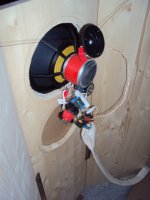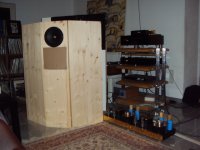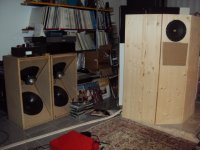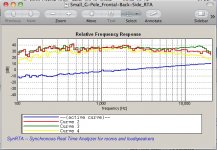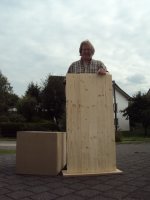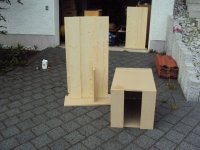Here are the measurements of the wizzer version on the foldable baffle, without and with the crossover. I used 1/6 octave smoothing because the driver has a complex micro structure. The ear works approximately the same way so i think the result is representative.
Attachments
I made a lot of changes to my system. I am listening most of the time now to the Enviee with wizzer on open baffles. First i though that in the upmost treble there is a minor loss of sparkle compared to the ribbon version but my G-Pole principle solved that so well that the total sound is even better then the standard MPL. Much more coherent and 3 dimensional and extremely open and dynamic without any fatigue. It is really hard to stand up and go to bed. Sleeping ? A waist of time if there where not this incredible dreams in the morning.
Really, how older i get the more realistic and on the other side surrealistic this dreams get. By the use of passive EQ and passive line filtering ( semi active ) i got now a phantastic result. See the latest measurements and then some pictures.
Really, how older i get the more realistic and on the other side surrealistic this dreams get. By the use of passive EQ and passive line filtering ( semi active ) i got now a phantastic result. See the latest measurements and then some pictures.
Attachments
Here is the right speaker with woofer, the left channel plus CD player and tube amps and a view from the back with passive EQ and recent addition of a far end Zobel to suppress RF ingress and oszilation.
My vinyl setup will be posted on MPP soon.
My vinyl setup will be posted on MPP soon.
Attachments
Joachim,
I read about your G-Pole principle in the linear-audio thread. From my poor understanding the typical dipole figure of 8 relies on the symmetry of front and back radiation. Since you are changing the back radiation above 1.5 kHz, the figure 8 should "degrade". Is that correct? In combination with the very wide baffle I would expect a serious widening of the radiation pattern above 1.5 kHz, followed by the final beaming caused by the finite diaphragm sizes front and rear.
Do you have any information to share what really happens to the radiation pattern above 1.5 kHz with G-Pole technology?
Rudolf
I read about your G-Pole principle in the linear-audio thread. From my poor understanding the typical dipole figure of 8 relies on the symmetry of front and back radiation. Since you are changing the back radiation above 1.5 kHz, the figure 8 should "degrade". Is that correct? In combination with the very wide baffle I would expect a serious widening of the radiation pattern above 1.5 kHz, followed by the final beaming caused by the finite diaphragm sizes front and rear.
Do you have any information to share what really happens to the radiation pattern above 1.5 kHz with G-Pole technology?
Rudolf
Yes, i will describe that in more detail in Linear Audio Vol.2. The main idea of the G-Pole
principle is A : Destroy the impulse response on the back side of the dipole. I do this with a back firing tweeter. It is time delayed and reversed in polarity, can be used with normal polarity too but most of the time i keep it reversed. This time delay causes comb filtering.
The impulse response to the back looks really horrid. The idea is to prevent a phantom image to the back. Standing behind the G-Pole it sounds totally diffuse.
B: shape the back radiation in such a way so that sound coming from the back of the G-Pole to the listening seat sounds tonally the same as the direct front radiation. I am using Zwickers diffuse field curve so ideally speaking it should be somewhat suppressed in the 1kHz region, then somewhat going up between 2 - 5 KHz and then again somewhat suppressed in the 10kHz region. If the back radiation from a dipole is the same then the front radiation, like for example the Nao-Note, then the diffuse part will sound slightly dark because of the subjective presence did in the unequalized diffuse radiation.
Also that kind of speaker will throw a strong phantom source to the back. It is argued that when the back radiation is delayed by more then 6 msec ( Linkwitz att.all. ) the Haas effect suppresses problems with imaging. I thought that too until i heard a G-Pole.
The radiation pattern i got has to be studied more in detail and is dependent on the actual build. I will show in Linear Audio a smaller dipole that will also be analysed in the radiation pattern. I promised Jan to delay that information somewhat.
principle is A : Destroy the impulse response on the back side of the dipole. I do this with a back firing tweeter. It is time delayed and reversed in polarity, can be used with normal polarity too but most of the time i keep it reversed. This time delay causes comb filtering.
The impulse response to the back looks really horrid. The idea is to prevent a phantom image to the back. Standing behind the G-Pole it sounds totally diffuse.
B: shape the back radiation in such a way so that sound coming from the back of the G-Pole to the listening seat sounds tonally the same as the direct front radiation. I am using Zwickers diffuse field curve so ideally speaking it should be somewhat suppressed in the 1kHz region, then somewhat going up between 2 - 5 KHz and then again somewhat suppressed in the 10kHz region. If the back radiation from a dipole is the same then the front radiation, like for example the Nao-Note, then the diffuse part will sound slightly dark because of the subjective presence did in the unequalized diffuse radiation.
Also that kind of speaker will throw a strong phantom source to the back. It is argued that when the back radiation is delayed by more then 6 msec ( Linkwitz att.all. ) the Haas effect suppresses problems with imaging. I thought that too until i heard a G-Pole.
The radiation pattern i got has to be studied more in detail and is dependent on the actual build. I will show in Linear Audio a smaller dipole that will also be analysed in the radiation pattern. I promised Jan to delay that information somewhat.
Gerhard, that sounds (sic) brilliant.
I happened to stumble accross a paper about decorrelation a short while back (probably posted here somewhere, I guess) : http://atlas.dxarts.washington.edu/courses/567/08WIN/KendallDecorrelation_lr.pdf
Quite a few aspects that Kendall discusses seem to apply here, too, in a slightly shifted context.
However, your decorrelation method is really just a (certainly short) delay (+ some minor phase shift from the EQing, and polarity flip), or do I miss something essential? A short statement would do, will wait for the LA article anyway.
- Klaus
I happened to stumble accross a paper about decorrelation a short while back (probably posted here somewhere, I guess) : http://atlas.dxarts.washington.edu/courses/567/08WIN/KendallDecorrelation_lr.pdf
Quite a few aspects that Kendall discusses seem to apply here, too, in a slightly shifted context.
However, your decorrelation method is really just a (certainly short) delay (+ some minor phase shift from the EQing, and polarity flip), or do I miss something essential? A short statement would do, will wait for the LA article anyway.
- Klaus
That paper looks interesting and "decorrrelation" is a good word to use for the effect.
I will read it more care full the next days.
Sure, it is just that little tweeter that hangs in the back that does the trick for me ( post 184, right picture ). I will post a phase measurement from the front and the back of the smaller G-Pole i will describe in Jan´s periodical soon. Then you see how fracked it is by this small measure.
I am also convinced that my idea can be refined and optimized so i do not say that i understand everything what is going on, maybe never will. It has light up a spark in me though. I think it has merit.
I will read it more care full the next days.
Sure, it is just that little tweeter that hangs in the back that does the trick for me ( post 184, right picture ). I will post a phase measurement from the front and the back of the smaller G-Pole i will describe in Jan´s periodical soon. Then you see how fracked it is by this small measure.
I am also convinced that my idea can be refined and optimized so i do not say that i understand everything what is going on, maybe never will. It has light up a spark in me though. I think it has merit.
Thanks Gerhard. The EQ'ing is clear to me already (knowing the literature and from experimenting)
Since I personally use a unbaffled 15"/2"-PA-coax I was thinking about a rear firing helper tweeter too, to get more balance between direct and reverberated sound and I was considering deliberate decorrelation, too. As everything is fully active DSP-controlled implementing variations of decorelation would be quite easy to implement.
- Klaus
Since I personally use a unbaffled 15"/2"-PA-coax I was thinking about a rear firing helper tweeter too, to get more balance between direct and reverberated sound and I was considering deliberate decorrelation, too. As everything is fully active DSP-controlled implementing variations of decorelation would be quite easy to implement.
- Klaus
Here is the unsmoothed transfer function of the Mini MPP G-Pole from the back side. This is the speaker i will describe more in Linear Audio. As you see the phase response is all over the place. I deducted exactly the time of flight from the microphone.
Attachments
Not many people can place an MPL baffle with 120cm width or the Betzy style version with 140cm width so i decided to design a baffle with 60cm width. The baffle step will be taken care of like in the Mini MPL by using an additional driver in the deeper midrange. For my personal build i will use an Enviee wizzer version for the top driver and an standard Enviee in the deeper mid.There will be a tweeter on the back to arrive at my G-Pole radiation pattern. That is an expensive driver set for the uncompromising but i will also make a version based on the SEAS ferrite wideband driver. I also designed a new woofer that is simpler then my M-dipoles. It is a cardioide based on a U-profile.
I talked to Holger Barske and there is a chance that he will publish this combination as a DIY kit in Klang und Ton.
I talked to Holger Barske and there is a chance that he will publish this combination as a DIY kit in Klang und Ton.
Attachments
This is really cool :
The Slot Loaded Open Baffle Project Article By Nelson Pass
The Slot Loaded Open Baffle Project Article By Nelson Pass
